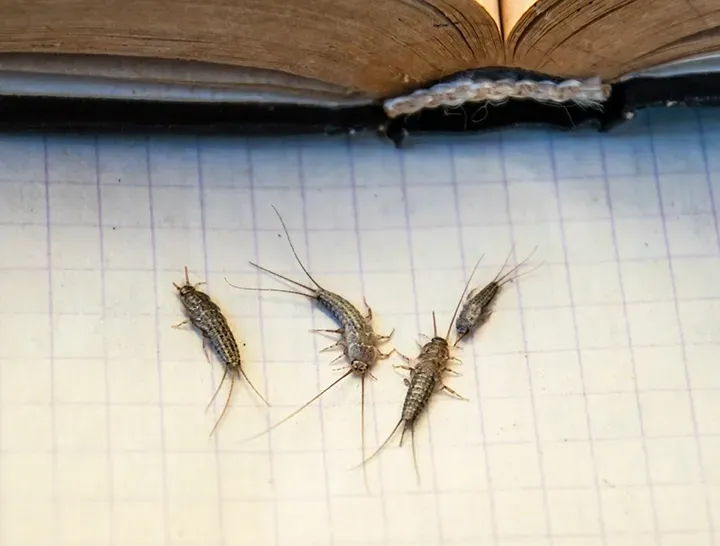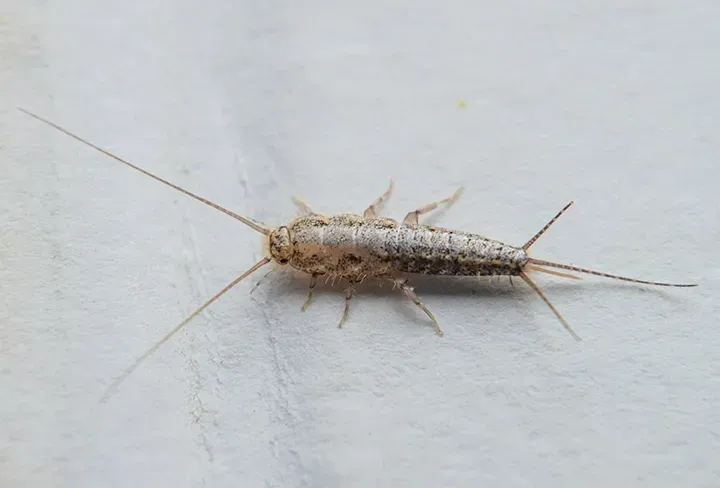Silverfish
Fleas are tiny, parasitic insects that can quickly become a nuisance in homes, especially for pet owners. These pests feed on the blood of animals and humans, causing discomfort through bites and potential allergic reactions.
Fleas are not just a seasonal problem; they can thrive indoors year-round, hiding in carpets, upholstery, and pet bedding. Left untreated, a small flea issue can escalate into a full-blown infestation, making it important for homeowners to understand how to promptly prevent and address flea problems.
If you have any questions, here are a few of the frequently asked questions.

Welcome to our FAQ section on silverfish control! Here, we address the most common questions and concerns homeowners have regarding silverfish infestations. From understanding what silverfish are and why they invade your home to effective prevention and control methods.
Our FAQs provide valuable insights to help you manage these pests. Whether you're dealing with a current infestation or looking for tips to prevent one, our expert answers will guide you toward a pest-free environment. Explore our FAQs to learn more about keeping your home safe and comfortable!
1. What are silverfish, and why are they in my home?
Silverfish are small, wingless insects with a metallic appearance and fish-like movements. They are attracted to dark, damp environments and feed on starchy materials, such as paper, glue, and fabrics. They enter homes in search of food and moisture.
2. Are silverfish harmful to humans or pets?
Silverfish are not harmful to humans or pets as they do not bite, sting, or transmit diseases. However, they can cause damage to household items, such as books, wallpaper, and clothing.
3. What are the signs of a silverfish infestation?
Common signs include seeing the insects themselves, finding small holes or notches in paper or fabric items, yellow stains, and pepper-like droppings near infested areas.
4. What attracts silverfish to my home?
Silverfish are attracted to moisture, food sources like paper and clothing, and warm, dark areas. Leaky pipes, damp basements, and cluttered attics are common attractants.
5. How can I prevent a silverfish infestation?
To prevent an infestation, reduce humidity levels in your home, seal cracks and crevices, store food and books in airtight containers, and eliminate clutter in dark, hidden areas.
6. What should I do if I see silverfish in my home?
If you see silverfish, it's essential to identify and eliminate the moisture source, clean and declutter the affected areas, and use traps or natural repellents like diatomaceous earth. If the problem persists, consider contacting a pest control professional.
7. Can silverfish damage my home or belongings?
Yes, silverfish can cause damage by eating through materials containing cellulose, starch, or protein, such as books, wallpaper, cardboard, and certain fabrics. They can also damage stored food.
8. Are there any natural remedies to get rid of silverfish?
Yes, natural remedies include using diatomaceous earth, boric acid, or essential oils like lavender or citrus as repellents. Reducing humidity with a dehumidifier can also help deter them.
9. How do professionals treat silverfish infestations?
Pest control professionals use a combination of methods, including targeted insecticide treatments, traps, and recommendations for reducing humidity and sealing entry points.
10.How long does it take to get rid of a silverfish infestation?
The time required to eliminate a silverfish infestation depends on the severity of the problem and the treatment methods used. It can take a few weeks to several months with regular monitoring and treatment.
Understanding the types of beetles in your household
Understanding the different types of silverfish helps homeowners identify and effectively address infestations. Each species has unique behaviors and habitats, enabling homeowners to recognize specific signs of their presence, such as feeding damage or droppings. This knowledge allows for tailored prevention and control strategies, enhancing pest control efforts and reducing the likelihood of future infestations.

1. Common Silverfish (Lepisma saccharinum)
This is the most widespread species and is recognizable by its silvery color and fish-like movements. Commonly found in homes, it thrives in dark, damp areas and feeds on starches found in paper, glue, and fabrics.
2. Gray Silverfish (Ctenolepisma longicaudatum)
Slightly larger than the common silverfish, gray silverfish are grayish-brown and have long, slender bodies. They are often found in similar environments and also feed on starchy materials.
3. Firebrat (Thermobia domestica)
Firebrats are similar in appearance to silverfish but are typically brown and prefer warmer environments, such as near heating vents, fireplaces, and attics. They also feed on starches and can thrive at higher temperatures.
4. Ctenolepisma (Ctenolepisma spp.)
This genus includes several species that are often mistaken for silverfish. They are typically smaller and can vary in color, with some being more reddish-brown. Like other silverfish, they are attracted to moisture and starchy materials.
Silverfish extermination control services for a hassle-free experience.
At GetLocal Services, our platform's transparent pest control pricing eliminates the need for price shopping. Our system provides you with the best price based on the experience and qualifications of our thoroughly vetted exterminators.
Our professional network members undergo a rigorous vetting process to ensure they meet our high standards. This guarantees that you receive top-quality service at a fair price, making your experience with us completely hassle-free.
Avoiding Annoying Sales Calls
One significant advantage of using GetLocal Services is avoiding the annoyance of multiple sales calls from vendors vying for your business.
Once you select an exterminator through our platform, you won’t be bombarded with follow-up calls from other vendors. This ensures a stress-free experience, allowing you to focus on resolving your silverfish problem easily.
Our professionals are available in your area if you need a silverfish exterminator.
If you’re facing an infestation, our local exterminators are here to help. We specialize in treating the specific types of silverfish in your area, using effective methods to eliminate the problem and prevent future issues. Contact us today to schedule an inspection and keep your home pest-free.
DELAWARE
FLORIDA
GEORGIA
NEW JERSEY
PENNSYLVANIA
NORTH CAROLINA

Money-Back Guarantee!
Unhappy with the service? We'll send another provider. Still unsatisfied? Our money-back guarantee will make it right.
GetLocal Hassle-Free Home Services
ARE YOU A HOME SERVICES PROFESSIONAL?
Partner with us to connect with homeowners who seek trusted professionals, boosting your visibility and reputation in your community.

SERVICES
TOP LOCAL SERVICE AREAS
- New Jersey
- North Carolina
- Florida
- Georgia
- Pennsylvania
- Delaware
- USA
JOIN OUR MAILING LIST
Sign up for home services tips and more
Join the Newsletter
We will get back to you as soon as possible
Please try again later
Copyright, GetLocal Services, LLC. | All Rights Reserved. | Terms of Use | Privacy Policy








